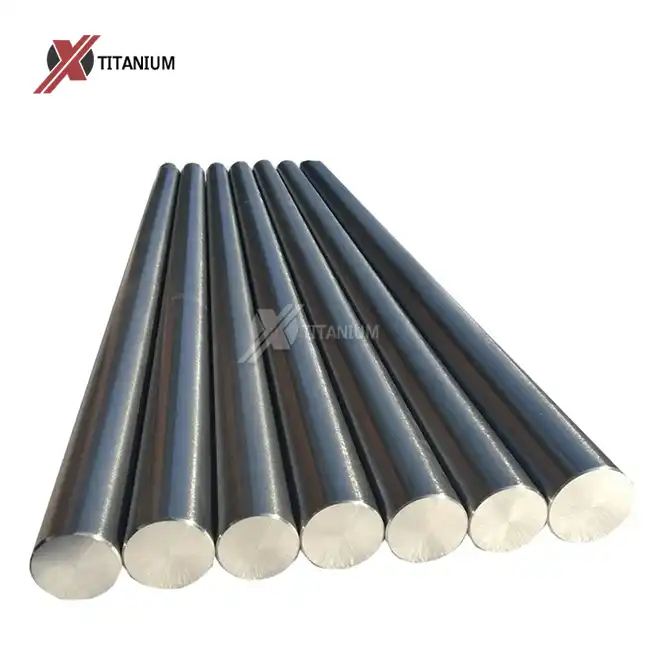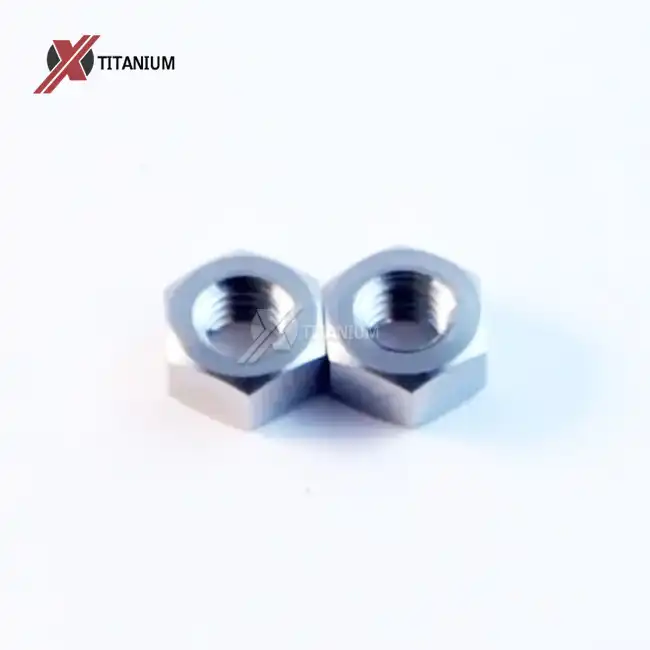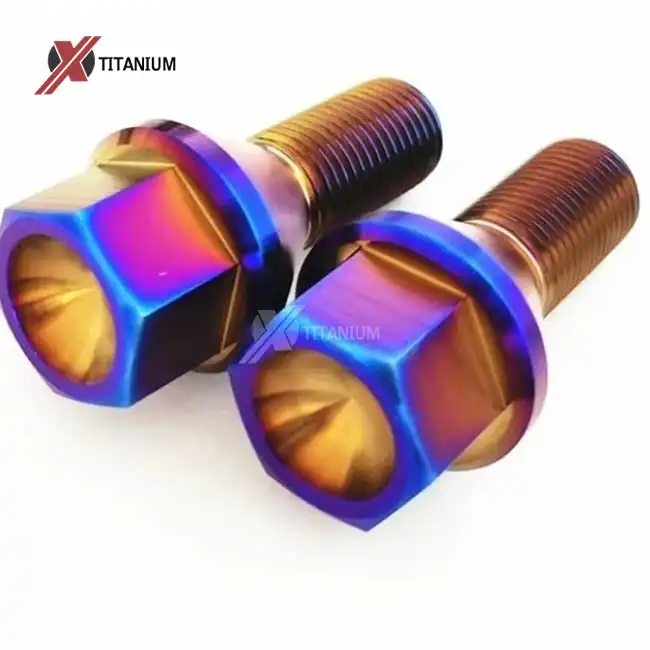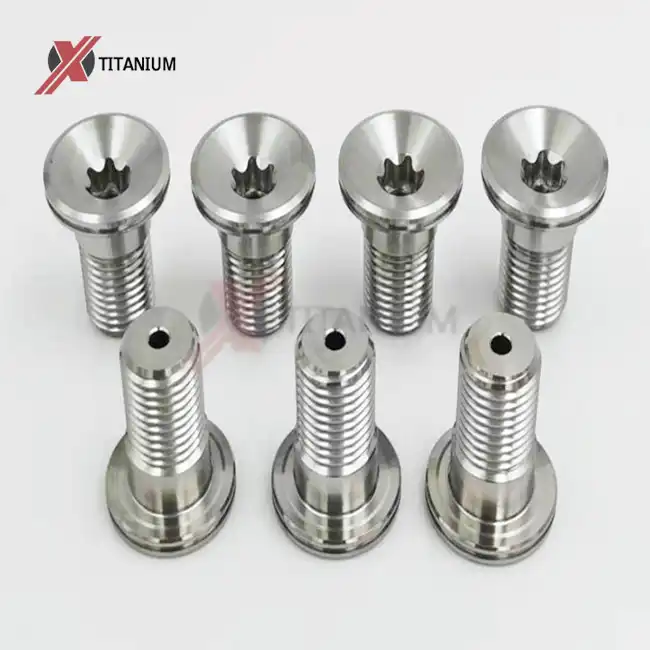The Composition and Properties of Titanium Alloy Rods
Understanding Titanium Alloys
Titanium alloy rods are crafted from a carefully engineered blend of titanium and other elements, resulting in materials that surpass the capabilities of pure titanium. The most common titanium alloys used in rod production are Grade 5 (Ti-6Al-4V) and Grade 9 (Ti-3Al-2.5V). These alloys incorporate elements such as aluminum and vanadium to enhance specific properties, creating a material that's both lighter and stronger than many steels.
The unique atomic structure of titanium alloys contributes to their remarkable strength. The hexagonal close-packed (HCP) crystal structure of titanium, combined with the added alloying elements, creates a material that resists deformation and maintains its integrity under high stress. This structural advantage is key to the exceptional performance of titanium alloy rods in demanding applications.
Key Properties of Titanium Alloy Rods
Titanium alloy rods boast an impressive array of properties that set them apart from other materials:
- Exceptional Strength: With a tensile strength ranging from 900 to 1100 MPa and a yield strength of 700 to 950 MPa, titanium alloy rods offer robust performance in high-stress environments.
- Low Density: Despite their strength, titanium alloys maintain a relatively low density, making them ideal for applications where weight is a critical factor.
- Corrosion Resistance: Titanium alloys form a protective oxide layer when exposed to air, providing excellent resistance to corrosion in various environments, including marine and chemical settings.
- Thermal Stability: These materials maintain their properties across a wide temperature range, making them suitable for both cryogenic and high-temperature applications.
- Biocompatibility: Titanium alloys are non-toxic and well-tolerated by the human body, making them an excellent choice for medical implants and devices.
The combination of these properties makes titanium alloy rods an invaluable resource across diverse industries, from aerospace to chemical processing.
Manufacturing Processes and Customization Options
Production Techniques for Titanium Alloy Rods
The manufacturing of titanium alloy rods involves sophisticated processes designed to optimize their properties and ensure consistency. Some of the key techniques employed include:
- Cold Rolling: This process involves passing the titanium alloy through rollers at room temperature, which increases its strength and hardness while improving surface finish.
- Hot Rolling: Performed at elevated temperatures, hot rolling allows for significant deformation of the material, shaping it into rods while maintaining its ductility.
- Annealing: Heat treatment through annealing helps relieve internal stresses, improve ductility, and enhance the overall microstructure of the titanium alloy rods.
- Pickling: This chemical process removes surface impurities and oxides, resulting in a clean, corrosion-resistant surface.
Each of these processes contributes to the final properties of the titanium alloy rods, allowing manufacturers to tailor the material to specific application requirements.
Customization Options for Titanium Alloy Rods
The versatility of titanium alloy rods extends to their customization options, allowing for precise tailoring to meet diverse industrial needs:
- Diameter Range: Titanium alloy rods can be produced in a wide range of diameters, typically from 5mm to 200mm, catering to various application requirements.
- Length Options: Manufacturers offer custom lengths to accommodate specific project needs, enhancing the flexibility of titanium alloy rods in different applications.
- Surface Finishes: Depending on the intended use, titanium alloy rods can be finished with various surface treatments:
- Bright finish for a smooth, reflective surface
- Polished finish for enhanced aesthetics and reduced friction
- Pickled surface for improved corrosion resistance
- Acid cleaning for removing contaminants
- Sandblasting for a matte, textured finish
- Hardness Levels: Through heat treatment and processing techniques, the hardness of titanium alloy rods can be adjusted, typically ranging from 35 to 40 HRC (Rockwell C scale).
These customization options allow industries to obtain titanium alloy rods that precisely match their specific requirements, optimizing performance and efficiency in their applications.
Applications and Industrial Value of Titanium Alloy Rods
Diverse Applications Across Industries
The unique properties of titanium alloy rods have led to their adoption in a wide range of industries and applications:
- Aerospace: In aircraft and spacecraft construction, titanium alloy rods are used for structural components, fasteners, and landing gear parts, taking advantage of their high strength-to-weight ratio.
- Medical: The biocompatibility of titanium alloys makes them ideal for orthopedic implants, dental implants, and surgical instruments.
- Chemical Processing: Corrosion-resistant titanium alloy rods are crucial in the construction of chemical processing equipment, valves, and piping systems.
- Marine Engineering: From offshore oil rigs to submarine components, titanium alloy rods provide durability in harsh marine environments.
- Automotive: High-performance vehicles utilize titanium alloy rods in engine components, suspension systems, and exhaust systems to reduce weight and improve performance.
- Sports Equipment: Golf clubs, bicycle frames, and other high-end sports equipment benefit from the strength and lightweight properties of titanium alloys.
The versatility of titanium alloy rods in these diverse applications underscores their significant industrial value.
Economic and Performance Benefits
While titanium alloy rods may have a higher initial cost compared to some alternatives, their long-term economic benefits are substantial:
- Extended Lifespan: The exceptional durability and corrosion resistance of titanium alloy rods result in longer service life, reducing the frequency of replacements and associated costs.
- Reduced Maintenance: Their resistance to wear and corrosion minimizes the need for regular maintenance, leading to lower operational costs over time.
- Weight Savings: In applications where weight is a critical factor, such as aerospace, the use of titanium alloy rods can lead to significant fuel savings and increased payload capacity.
- Enhanced Performance: The superior strength and thermal stability of titanium alloy rods can improve the overall performance and efficiency of systems and equipment.
- Sustainability: The longevity and recyclability of titanium alloys contribute to more sustainable industrial practices, aligning with growing environmental concerns.
These economic and performance benefits make titanium alloy rods a wise investment for industries seeking long-term value and reliability in their materials.
Conclusion
Titanium alloy rods represent a pinnacle of materials engineering, offering an extraordinary blend of strength, durability, and versatility. Their unique properties, including high strength-to-weight ratio, excellent corrosion resistance, and biocompatibility, make them indispensable in industries ranging from aerospace to medicine. The ability to customize these rods through various manufacturing processes and surface treatments further enhances their adaptability to specific industrial needs. While the initial investment may be higher, the long-term economic benefits and performance advantages of titanium alloy rods make them a valuable asset in numerous applications, contributing to innovation, efficiency, and sustainability across diverse sectors.
At Baoji Chuanglian New Metal Material Co., Ltd., we specialize in the production of high-quality titanium alloy rods tailored to meet the exacting demands of various industries. Our expertise in titanium product manufacturing ensures that you receive customized titanium alloy rods that perfectly align with your project requirements. For more information on our titanium alloy rod offerings or to discuss your specific needs, please don't hesitate to contact us at info@cltifastener.com or djy6580@aliyun.com.
FAQs
What are the main grades of titanium alloy used in rod production?
The most common grades are Grade 5 (Ti-6Al-4V) and Grade 9 (Ti-3Al-2.5V), known for their excellent strength and corrosion resistance.
How do titanium alloy rods compare to stainless steel in terms of corrosion resistance?
Titanium alloy rods generally offer superior corrosion resistance compared to stainless steel, especially in marine and chemical environments.
Can titanium alloy rods be customized for specific applications?
Yes, titanium alloy rods can be customized in terms of diameter (5mm - 200mm), length, surface finish, and even specific alloy composition to meet various industrial needs.
What makes titanium alloy rods suitable for medical implants?
Their biocompatibility, corrosion resistance, and strength make titanium alloy rods ideal for medical implants, as they are well-tolerated by the human body.
How do the manufacturing processes affect the properties of titanium alloy rods?
Processes like cold rolling, hot rolling, annealing, and pickling can enhance strength, improve surface finish, relieve internal stresses, and increase corrosion resistance in titanium alloy rods.
References
1. Peters, M., Kumpfert, J., Ward, C. H., & Leyens, C. (2003). Titanium alloys for aerospace applications. Advanced Engineering Materials, 5(6), 419-427.
2. Lutjering, G., & Williams, J. C. (2007). Titanium (2nd ed.). Springer-Verlag Berlin Heidelberg.
3. Rack, H. J., & Qazi, J. I. (2006). Titanium alloys for biomedical applications. Materials Science and Engineering: C, 26(8), 1269-1277.
4. Boyer, R. R. (1996). An overview on the use of titanium in the aerospace industry. Materials Science and Engineering: A, 213(1-2), 103-114.
4. Donachie, M. J. (2000). Titanium: A Technical Guide (2nd ed.). ASM International.




_1747364744942.webp)